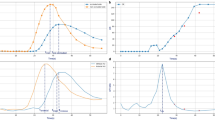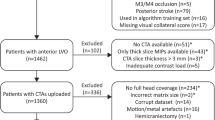Abstract
Purpose
Collateral grading may vary on single-phase CTA (sCTA) depending on whether the CTA is arterial (A), arteriovenous (AV), or venous (V) weighted. We studied the impact of sCTA weighting on collateral grading using the Tan, MAAS, and Menon methods, and their ability to predict infarct and clinical outcome hypothesizing that AV-weighted sCTA should better predict these outcomes.
Methods
Multicenter retrospective analysis of 212 patients undergoing baseline CTP/sCTA. sCTA weighting was determined by comparing ICA to torcula AV ratios with those from concomitant CTP time-density curves at peak arterial or venous contrast attenuation. A generalized linear mixed model investigated the predictive value for infarct volume or 90-day mRS of the three collateral scores stratified by sCTA weighting and adjusting for age, sex, clot burden score (CBS), and NIHSS. Bayesian information criterion (BIC) differences were calculated between the null and fitted models.
Results
Mean age, baseline median NIHSS, ASPECTS, and onset to treatment time were 69.89 ± 14.45, 13 (6–18), 10 (8–10), and 128 (66–181) minutes. sCTA scans were AV-weighted in 137/212 (65%) and A-weighted in 73 (34%). No association was demonstrated between sCTA weighting, hospital site, and sCTA technique. All collateral scores were related to infarct volume irrespective of sCTA weighting, with greatest fit with the regional leptomeningeal score (BIC 18.29, p = 0.0001). No association was shown between sCTA weighting, collateral grade, and clinical outcome.
Conclusion
sCTA weighting did not significantly impact collateral grade using three common collateral scores or their ability to predict final infarct.



Similar content being viewed by others
References
Fanou EM, Knight J, Aviv RI, Hojjat SP, Symons SP, Zhang L, Wintermark M (2015) Effect of collaterals on clinical presentation, baseline imaging, complications, and outcome in acute stroke. AJNR Am J Neuroradiol 36:2285–2291
Smit EJ, Vonken EJ, van Seeters T, Dankbaar JW, van der Schaaf IC, Kappelle LJ, van Ginneken B, Velthuis BK, Prokop M (2013) Timing-invariant imaging of collateral vessels in acute ischemic stroke. Stroke 44:2194–2199
Lima FO, Furie KL, Silva GS, Lev MH, Camargo ECS, Singhal AB, Harris GJ, Halpern EF, Koroshetz WJ, Smith WS, Yoo AJ, Nogueira RG (2010) The pattern of leptomeningeal collaterals on CT angiography is a strong predictor of long-term functional outcome in stroke patients with large vessel intracranial occlusion. Stroke 41:2316–2322
Lima FO, Furie KL, Silva GS, Lev MH, Camargo ÉCS, Singhal AB, Harris GJ, Halpern EF, Koroshetz WJ, Smith WS, Nogueira RG (2014) Prognosis of untreated strokes due to anterior circulation proximal intracranial arterial occlusions detected by use of computed tomography angiography. JAMA Neurol 71:151–157
Song D, Lee K, Kim EH, Kim YD, Kim J, Song TJ, Lee HS, Nam HS, Heo JH (2015) Value of utilizing both aspects and CT angiography collateral score for outcome prediction in acute ischemic stroke. Int J Stroke 10:1018–1023
Miteff F, Levi CR, Bateman GA, Spratt N, McElduff P, Parsons MW (2009) The independent predictive utility of computed tomography angiographic collateral status in acute ischaemic stroke. Brain 132:2231–2238
Calleja AI, Cortijo E, Garcia-Bermejo P et al (2013) Collateral circulation on perfusion-computed tomography-source images predicts the response to stroke intravenous thrombolysis. Eur J Neurol 20:795–802
Frolich AM, Wolff SL, Psychogios MN et al (2014) Time-resolved assessment of collateral flow using 4D CT angiography in large-vessel occlusion stroke. Eur Radiol 24:390–396
Menon BK, d’Esterre CD, Qazi EM et al (2015) Multiphase CT angiography: a new tool for the imaging triage of patients with acute ischemic stroke. Radiology 275:510–520
van den Wijngaard IR, Holswilder G, Wermer MJ et al (2016) Assessment of collateral status by dynamic CT angiography in acute MCA stroke: timing of acquisition and relationship with final infarct volume. AJNR Am J Neuroradiol 37:1231–1236
van den Wijngaard IR, Boiten J, Holswilder G, Algra A, Dippel DWJ, Velthuis BK, Wermer MJH, van Walderveen MAA (2015) Impact of collateral status evaluated by dynamic computed tomographic angiography on clinical outcome in patients with ischemic stroke. Stroke 46:3398–3404
Tan JC, Dillon WP, Liu S, Adler F, Smith WS, Wintermark M (2007) Systematic comparison of perfusion-CT and CT-angiography in acute stroke patients. Ann Neurol 61:533–543
Maas MB, Lev MH, Ay H, Singhal AB, Greer DM, Smith WS, Harris GJ, Halpern E, Kemmling A, Koroshetz WJ, Furie KL (2009) Collateral vessels on CT angiography predict outcome in acute ischemic stroke. Stroke 40:3001–3005
Menon BK, Smith EE, Modi J, Patel SK, Bhatia R, Watson TWJ, Hill MD, Demchuk AM, Goyal M (2011) Regional leptomeningeal score on CT angiography predicts clinical and imaging outcomes in patients with acute anterior circulation occlusions. AJNR Am J Neuroradiol 32:1640–1645
Beyer SE, Thierfelder KM, von Baumgarten L, Rottenkolber M, Meinel FG, Janssen H, Ertl-Wagner B, Reiser MF, Sommer WH (2015) Strategies of collateral blood flow assessment in ischemic stroke: prediction of the follow-up infarct volume in conventional and dynamic CTA. AJNR Am J Neuroradiol 36:488–494
Menon BK, d’Esterre CD, Qazi EM, et al. (2015) Multiphase CT angiography: a new tool for the imaging triage of patients with acute ischemic stroke. Radiology 275(275):510–520
Rodriguez-Luna D, Dowlatshahi D, Aviv RI, Molina CA, Silva Y, Dzialowski I, Lum C, Czlonkowska A, Boulanger JM, Kase CS, Gubitz G, Bhatia R, Padma V, Roy J, Stewart T, Huynh TJ, Hill MD, Demchuk AM, on behalf of the PREDICT/Sunnybrook ICH CTA Study Group (2014) Venous phase of computed tomography angiography increases spot sign detection, but intracerebral hemorrhage expansion is greater in spot signs detected in arterial phase. Stroke 45:734–739
Bivard A, Levi C, Krishnamurthy V, McElduff P, Miteff F, Spratt NJ, Bateman G, Donnan G, Davis S, Parsons M (2015) Perfusion computed tomography to assist decision making for stroke thrombolysis. Brain 138:1919–1931
Bivard A, Lou M, Levi CR, Krishnamurthy V, Cheng X, Aviv RI, McElduff P, Lin L, Kleinig T, O’Brien B, Butcher K, Jingfen Z, Jannes J, Dong Q, Parsons MW (2016) Too good to treat? Ischemic stroke patients with small computed tomography perfusion lesions may not benefit from thrombolysis. Ann Neurol 80:286–293
Parsons MW, Pepper EM, Bateman GA, Wang Y, Levi CR (2007) Identification of the penumbra and infarct core on hyperacute noncontrast and perfusion CT. Neurology 68:730–736
Murphy A, Symons SP, Hopyan J, Aviv RI (2013) Factors influencing clinically meaningful recanalization after IV-rtPA in acute ischemic stroke. AJNR Am J Neuroradiol 34:146–152
Bivard A, Levi C, Spratt N, Parsons M (2013) Perfusion CT in acute stroke: a comprehensive analysis of infarct and penumbra. Radiology 267:543–550
Campbell BC, Christensen S, Tress BM, Churilov L, Desmond PM, Parsons MW, Barber PA, Levi CR, Bladin C, Donnan GA, Davis SM, EPITHET Investigators (2013) Failure of collateral blood flow is associated with infarct growth in ischemic stroke. J Cereb Blood Flow Metab 33:1168–1172
Goyal M, Demchuk AM, Menon BK, Eesa M, Rempel JL, Thornton J, Roy D, Jovin TG, Willinsky RA, Sapkota BL, Dowlatshahi D, Frei DF, Kamal NR, Montanera WJ, Poppe AY, Ryckborst KJ, Silver FL, Shuaib A, Tampieri D, Williams D, Bang OY, Baxter BW, Burns PA, Choe H, Heo JH, Holmstedt CA, Jankowitz B, Kelly M, Linares G, Mandzia JL, Shankar J, Sohn SI, Swartz RH, Barber PA, Coutts SB, Smith EE, Morrish WF, Weill A, Subramaniam S, Mitha AP, Wong JH, Lowerison MW, Sajobi TT, Hill MD, ESCAPE Trial Investigators (2015) Randomized assessment of rapid endovascular treatment of ischemic stroke. N Engl J Med 372:1019–1030
Berkhemer OA, Fransen PS, Beumer D, van den Berg L, Lingsma HF, Yoo AJ, Schonewille WJ, Vos JA, Nederkoorn PJ, Wermer MJ, van Walderveen M, Staals J, Hofmeijer J, van Oostayen J, Lycklama à Nijeholt GJ, Boiten J, Brouwer PA, Emmer BJ, de Bruijn SF, van Dijk L, Kappelle LJ, Lo RH, van Dijk E, de Vries J, de Kort PL, van Rooij W, van den Berg J, van Hasselt B, Aerden LA, Dallinga RJ, Visser MC, Bot JC, Vroomen PC, Eshghi O, Schreuder TH, Heijboer RJ, Keizer K, Tielbeek AV, den Hertog H, Gerrits DG, van den Berg-Vos R, Karas GB, Steyerberg EW, Flach HZ, Marquering HA, Sprengers ME, Jenniskens SF, Beenen LF, van den Berg R, Koudstaal PJ, van Zwam W, Roos YB, van der Lugt A, van Oostenbrugge R, Majoie CB, Dippel DW, MR CLEAN Investigators (2015) A randomized trial of intraarterial treatment for acute ischemic stroke. N Engl J Med 372:11–20
Campbell BC, Mitchell PJ, Kleinig TJ, Dewey HM, Churilov L, Yassi N, Yan B, Dowling RJ, Parsons MW, Oxley TJ, Wu TY, Brooks M, Simpson MA, Miteff F, Levi CR, Krause M, Harrington TJ, Faulder KC, Steinfort BS, Priglinger M, Ang T, Scroop R, Barber PA, McGuinness B, Wijeratne T, Phan TG, Chong W, Chandra RV, Bladin CF, Badve M, Rice H, de Villiers L, Ma H, Desmond PM, Donnan GA, Davis SM, EXTEND-IA Investigators (2015) Endovascular therapy for ischemic stroke with perfusion-imaging selection. N Engl J Med 372:1009–1018
Jovin TG, Chamorro A, Cobo E, de Miquel MA, Molina CA, Rovira A, San Román L, Serena J, Abilleira S, Ribó M, Millán M, Urra X, Cardona P, López-Cancio E, Tomasello A, Castaño C, Blasco J, Aja L, Dorado L, Quesada H, Rubiera M, Hernandez-Pérez M, Goyal M, Demchuk AM, von Kummer R, Gallofré M, Dávalos A, REVASCAT Trial Investigators (2015) Thrombectomy within 8 hours after symptom onset in ischemic stroke. N Engl J Med 372:2296–2306
Saver JL, Goyal M, Bonafe A, Diener HC, Levy EI, Pereira VM, Albers GW, Cognard C, Cohen DJ, Hacke W, Jansen O, Jovin TG, Mattle HP, Nogueira RG, Siddiqui AH, Yavagal DR, Baxter BW, Devlin TG, Lopes DK, Reddy VK, du Mesnil de Rochemont R, Singer OC, Jahan R, SWIFT PRIME Investigators (2015) Stent-retriever thrombectomy after intravenous t-PA vs. t-PA alone in stroke. N Engl J Med 372:2285–2295
Maier IL, Scalzo F, Leyhe JR, Schregel K, Behme D, Tsogkas I, Psychogios MN, Liebeskind DS (2018) Validation of collateral scoring on flat-detector multiphase CT angiography in patients with acute ischemic stroke. PLoS One 13:e0202592
Author information
Authors and Affiliations
Corresponding author
Ethics declarations
Funding
This project was funded by a National Health and Medical Research Council Australia Partnership Project Grant (APP1013719). NS is funded by a National Health and Medical Research Council/National Heart Foundation co-funded Career Development/Future Leader Fellowship (APPS1110629/100827). CL is funded by a National Health and Medical Research Council Practitioner Fellowship (APP 1043913).
Conflict of interest
The authors declare that they have no conflict of interest.
Ethical approval
All procedures performed in studies involving human participants were in accordance with the ethical standards of the institutional and/or national research committee and with the 1964 Helsinki declaration and its later amendments or comparable ethical standards.
Informed consent
Informed consent was obtained from all individual participants included in the study.
Electronic supplementary material
ESM 1
(DOCX 16 kb)
Rights and permissions
About this article
Cite this article
Bisson, DA., Mahmoudian, D., Shatil, A.S. et al. Single-phase CT angiography: collateral grade is independent of scan weighting. Neuroradiology 61, 19–28 (2019). https://doi.org/10.1007/s00234-018-2105-2
Received:
Accepted:
Published:
Issue Date:
DOI: https://doi.org/10.1007/s00234-018-2105-2




